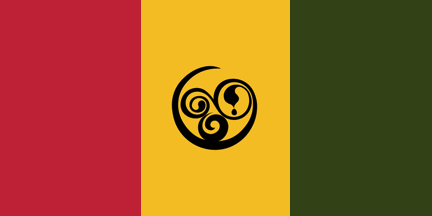
Last modified: 2021-04-17 by rob raeside
Keywords: african nova scotian flag | nova scotia |
Links: FOTW homepage |
search |
disclaimer and copyright |
write us |
mirrors
 image by
Ivan Sache, 13 March 2021
image by
Ivan Sache, 13 March 2021See also:
The African Nova Scotian Community is officially recognized by the Province
of Nova Scotia:
https://ansa.novascotia.ca/community
And the flag is official:
https://www.cbc.ca/news/canada/nova-scotia/african-nova-scotian-flag-ceremony-1.5914577
There are 20,790 African Nova Scotians according to 2011 National Household
Survey (NHS) conducted by Statistics Canada (which is the most recent
statistical information available). African Nova Scotians make up the largest
racially visible group in Nova Scotia. They represent 44% of the racially
visible population which constitutes 2.3% of the total Nova Scotian population.
Explorer Mathieu Da Costa is credited with being the first to arrive as part
of an expedition that founded Port Royal in 1605. In the 1700s, small
populations of French and English Black settlers were part of colonial towns
such as Louisbourg and early Halifax.
The first large group of immigrants
were the Black Loyalists who came as refugees after the American Revolution
between 1782 and 1785. About 3,500 people settled throughout Nova Scotia in
communities such as Annapolis Royal, Clements, Granville, Birchtown,
Brindleytown, Preston, Little Tracadie, Chedabucto and Halifax. A group of 600
exiled Jamaican Maroons followed in 1796, settling in Preston Township. They
helped build Government House, worked on new fortifications at the Halifax
Citadel and served in the militia.
The War of 1812 between the United States
and Britain resulted in another era of significant migration. Roughly 2000 Black
Refugees seeking freedom arrived in Nova Scotia between 1813 and 1816. Many
settled in Halifax and Dartmouth, including two large groups in Hammonds Plains
and Preston. Others went to smaller communities around the province such as
Cobequid Road, Five Mile Plains, Beechville, Porter’s Lake, Fletcher’s Lake,
Prospect Road, Beaverbank, Avonport, Pine Woods, Pictou and Mill Village.
The
early 1900s saw the last historic group of black settlers arrive in Nova Scotia
as hundreds of Caribbean immigrants, known as the “later arrivals”, came to Cape
Breton to work in the steel mills and coal mines.
https://ansa.novascotia.ca/community
African Nova Scotian Affairs (ANSA)
- Government of the Province of Nova Scotia
The official African Nova
Scotian flag was raised at noon on 15 February 2021 outside the Black Cultural
Centre for Nova Scotia in Cherry Brook, N.S. The idea for an African Nova
Scotian flag has been many years in the making, designer Wendy Wilson said, but
the flag is being officially recognized for the first time this year. Wilson
came up with the idea when her daughter, now in her final year at university,
was researching Mi'kmaw, Acadian, and African Nova Scotian history for a
middle-school project. That's when Wilson, who is a visual artist, realized
there was no such thing as an African Nova Scotian flag. So she started
researching and designing a flag that could represent her heritage.
Wilson said each colour on the flag symbolizes something different; red for
blood and sacrifice, gold for cultural richness, green for fertility and growth,
and black for the people. The design in the middle of the flag is Wilson's
stylized adaptation of Sankofa, an ancient Adinkra symbol conceived in West
Africa, which signifies the importance of bringing past knowledge to the
present. Wilson's version incorporates a wave, representing the ocean and her
ancestors' journey through the Middle Passage. There's also half of a heart with
a yin and yang symbol, representing "heartbreak balanced with awareness."
"The image is encompassed within an incomplete circle, representing those things
absent but yet to come," she said during the live-streamed event.
Wilson
said although the process of making the flag official – reaching out to numerous
African Nova Scotian organizations and working with the province's office of
African Nova Scotian Affairs – was "daunting," it was necessary.
[...]
https://www.cbc.ca/news/canada/nova-scotia/african-nova-scotian-flag-ceremony-1.5914577
New official African Nova Scotian flag looking to connect past, present and
future - CBC, 15 February 2021
https://www.youtube.com/watch?v=aM88M9NtLmc
Flag inauguration ceremony -
YouTube, 17 February 2021 (flag hoisting starts at 15:00)
https://atlantic.ctvnews.ca/mobile/n-s-announces-3m-fund-for-land-title-claims-in-african-nova-scotian-communities-1.5335074
Flag use by Nova Scotia Premier - CTV News, 5 March 2021
https://twitter.com/SJAHigh/status/1356337320262332424
Flag hoisting in
Sir John A MacDonald High School, 1 February 2021
Ivan Sache, 12-13
March 2021